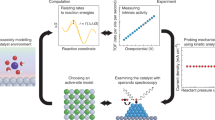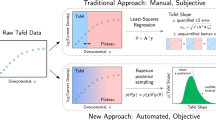Abstract
Heterogeneous electrocatalysis is critical to many energy conversion processes. Theoretical and computational approaches are essential to interpret experimental data and provide the mechanistic understanding necessary to design more effective catalysts. However, automated general procedures to build predictive theoretical and computational frameworks are not readily available; specific choices must be made in terms of the atomistic structural model and the level of theory, as well as the experimental data used to inform and validate these choices. Here we outline some best practices for modelling heterogeneous systems and present examples in the context of catalysis at metal electrodes and oxides. The level of theory should be chosen for the specific system and properties of interest, and experimental validation is essential from the beginning to the end of the study. Continuous feedback and ultimate integration between experiment and theory enhances the power of calculations to elucidate mechanisms, identify effective descriptors and clarify design principles.
This is a preview of subscription content, access via your institution
Access options
Access Nature and 54 other Nature Portfolio journals
Get Nature+, our best-value online-access subscription
$29.99 / 30 days
cancel any time
Subscribe to this journal
Receive 12 digital issues and online access to articles
$119.00 per year
only $9.92 per issue
Buy this article
- Purchase on Springer Link
- Instant access to full article PDF
Prices may be subject to local taxes which are calculated during checkout



Similar content being viewed by others
References
Greeley, J. Theoretical heterogeneous catalysis: scaling relationships and computational catalyst design. Annu. Rev. Chem. Biomol. 7, 605–635 (2016).
Bruix, A., Margraf, J. T., Andersen, M. & Reuter, K. First-principles-based multiscale modelling of heterogeneous catalysis. Nat. Catal. 2, 659–670 (2019).
Quesne, M. G., Silveri, F., de Leeuw, N. H. & Catlow, C. R. A. Advances in sustainable catalysis: a computational perspective. Front. Chem. 7, 182 (2019).
Schlexer Lamoureux, P. et al. Machine learning for computational heterogeneous catalysis. ChemCatChem 11, 3581–3601 (2019).
Cheng, J. & Sprik, M. Alignment of electronic energy levels at electrochemical interfaces. Phys. Chem. Chem. Phys. 14, 11245–11267 (2012).
Kharche, N., Muckerman, J. T. & Hybertsen, M. S. First-principles approach to calculating energy level alignment at aqueous semiconductor interfaces. Phys. Rev. Lett. 113, 176802 (2014).
Kharche, N., Muckerman, J. T. & Hybertsen, M. S. First-principles approach to calculating energy level alignment at aqueous semiconductor interfaces. Phys. Rev. Lett. 113, 176802 (2014).
Pham, T. A., Ping, Y. & Galli, G. Modelling heterogeneous interfaces for solar water splitting. Nat. Mater. 16, 401–408 (2017).
Rousseau, R., Glezakou, V.-A. & Selloni, A. Theoretical insights into the surface physics and chemistry of redox-active oxides. Nat. Rev. Mater. 5, 460–475 (2020).
Selcuk, S. & Selloni, A. Facet-dependent trapping and dynamics of excess electrons at anatase TiO2 surfaces and aqueous interfaces. Nat. Mater. 15, 1107–1112 (2016).
Gerosa, M., Gygi, F., Govoni, M. & Galli, G. The role of defects and excess surface charges at finite temperature for optimizing oxide photoabsorbers. Nat. Mater. 17, 1122–1127 (2018).
Janthon, P. et al. Bulk properties of transition metals: a challenge for the design of universal density functionals. J. Chem. Theory Comput. 10, 3832–3839 (2014).
Mandal, S., Haule, K., Rabe, K. M. & Vanderbilt, D. Systematic beyond-DFT study of binary transition metal oxides. NPJ Comput. Mater. 5, 115 (2019).
Lejaeghere, K. et al. Reproducibility in density functional theory calculations of solids. Science 351, aad3000 (2016).
Gauthier, J. A. et al. Unified approach to implicit and explicit solvent simulations of electrochemical reaction energetics. J. Chem. Theory Comput. 15, 6895–6906 (2019).
Verma, P. & Truhlar, D. G. Status and challenges of density functional theory. Trends Chem. 2, 302–318 (2020).
Perdew, J. P., Burke, K. & Ernzerhof, M. Generalized gradient approximation made simple. Phys. Rev. Lett. 77, 3865–3868 (1996).
Scherpelz, P., Govoni, M., Hamada, I. & Galli, G. Implementation and validation of fully relativistic GW calculations: spin–orbit coupling in molecules, nanocrystals, and solids. J. Chem. Theory Comput. 12, 3523–3544 (2016).
Andreussi, O., Dabo, I. & Marzari, N. Revised self-consistent continuum solvation in electronic-structure calculations. J. Chem. Phys. 136, 064102 (2012).
Hörmann, N. G., Andreussi, O. & Marzari, N. Grand canonical simulations of electrochemical interfaces in implicit solvation models. J. Chem. Phys. 150, 041730 (2019).
Solis, B. H. & Hammes-Schiffer, S. Proton-coupled electron transfer in molecular electrocatalysis: theoretical methods and design principles. Inorg. Chem. 53, 6427–6443 (2014).
Pham, T. A., Lee, D., Schwegler, E. & Galli, G. Interfacial effects on the band edges of functionalized Si surfaces in liquid water. J. Am. Chem. Soc. 136, 17071–17077 (2014).
Venkataraman, C., Soudackov, A. V. & Hammes-Schiffer, S. Theoretical formulation of nonadiabatic electrochemical proton-coupled electron transfer at metal−solution interfaces. J. Phys. Chem. C 112, 12386–12397 (2008).
Goldsmith, Z. K., Lam, Y. C., Soudackov, A. V. & Hammes-Schiffer, S. Proton discharge on a gold electrode from triethylammonium in acetonitrile: theoretical modeling of potential-dependent kinetic isotope effects. J. Am. Chem. Soc. 141, 1084–1090 (2019).
Lam, Y.-C., Soudackov, A. V. & Hammes-Schiffer, S. Kinetics of proton discharge on metal electrodes: effects of vibrational nonadiabaticity and solvent dynamics. J. Phys. Chem. Lett. 10, 5312–5317 (2019).
Lam, Y.-C., Soudackov, A. V. & Hammes-Schiffer, S. Theory of electrochemical proton-coupled electron transfer in diabatic vibronic representation: application to proton discharge on metal electrodes in alkaline solution. J. Phys. Chem. C 124, 27309–27322 (2020).
Bard, A. J. & Faulkner, L. R. Electrochemical Methods: Fundamentals and Applications 2nd edn (John Wiley & Sons, 2001).
Ulman, K., Poli, E., Seriani, N., Piccinin, S. & Gebauer, R. Understanding the electrochemical double layer at the hematite/water interface: a first principles molecular dynamics study. J. Chem. Phys. 150, 041707 (2018).
Jackson, M. N. & Surendranath, Y. Donor-dependent kinetics of interfacial proton-coupled electron transfer. J. Am. Chem. Soc. 138, 3228–3234 (2016).
Sakaushi, K. Quantum proton tunneling in multi-electron/-proton transfer electrode processes. Faraday Discuss. 221, 428–448 (2020).
Kastlunger, G., Lindgren, P. & Peterson, A. A. Controlled-potential simulation of elementary electrochemical reactions: proton discharge on metal surfaces. J. Phys. Chem. C 122, 12771–12781 (2018).
Goldsmith, Z. K., Secor, M. & Hammes-Schiffer, S. Inhomogeneity of interfacial electric fields at vibrational probes on electrode surfaces. ACS Cent. Sci. 6, 304–311 (2020).
Melander, M. M., Kuisma, M. J., Christensen, T. E. K. & Honkala, K. Grand-canonical approach to density functional theory of electrocatalytic systems: Thermodynamics of solid-liquid interfaces at constant ion and electrode potentials. J. Chem. Phys. 150, 041706 (2018).
Schkolnik, G. et al. Vibrational Stark effect of the electric-field reporter 4-mercaptobenzonitrile as a tool for investigating electrostatics at electrode/SAM/solution interfaces. Int. J. Mol. Sci. 13, 7466–7482 (2012).
Patrow, J. G., Sorenson, S. A. & Dawlaty, J. M. Direct spectroscopic measurement of interfacial electric fields near an electrode under polarizing or current-carrying conditions. J. Phys. Chem. C 121, 11585–11592 (2017).
Sorenson, S. A., Patrow, J. G. & Dawlaty, J. M. Solvation reaction field at the interface measured by vibrational sum frequency generation spectroscopy. J. Am. Chem. Soc. 139, 2369–2378 (2017).
Jackson, M. N. & Surendranath, Y. Molecular control of heterogeneous electrocatalysis through graphite conjugation. Acc. Chem. Res. 52, 3432–3441 (2019).
Warburton, R. E. et al. Interfacial field-driven proton-coupled electron transfer at graphite-conjugated organic acids. J. Am. Chem. Soc. 142, 20855–20864 (2020).
Lee, D. et al. The impact of surface composition on the interfacial energetics and photoelectrochemical properties of BiVO4. Nat. Energy 6, 287–294 (2021).
Wiktor, J. & Pasquarello, A. Electron and hole polarons at the BiVO4–water interface. ACS Appl. Mater. Interfaces 11, 18423–18426 (2019).
Wang, W. et al. The role of surface oxygen vacancies in BiVO4. Chem. Mater. 32, 2899–2909 (2020).
Goldsmith, Z. K. et al. Characterization of NiFe oxyhydroxide electrocatalysts by integrated electronic structure calculations and spectroelectrochemistry. Proc. Natl Acad. Sci. USA 114, 3050–3055 (2017).
Ping, Y., Goddard, W. A. & Galli, G. A. Energetics and solvation effects at the photoanode/catalyst interface: ohmic contact versus Schottky barrier. J. Am. Chem. Soc. 137, 5264–5267 (2015).
Spurgeon, J. M., Velazquez, J. M. & McDowell, M. T. Improving O2 production of WO3 photoanodes with IrO2 in acidic aqueous electrolyte. Phys. Chem. Chem. Phys. 16, 3623–3631 (2014).
Di Valentin, C. & Selloni, A. Bulk and surface polarons in photoexcited anatase TiO2. J. Phys. Chem. Lett. 2, 2223–2228 (2011).
Hoster, H. E., Alves, O. B. & Koper, M. T. M. Tuning adsorption via strain and vertical ligand effects. ChemPhysChem 11, 1518–1524 (2010).
van der Niet, M. J. T. C., Garcia-Araez, N., Hernández, J., Feliu, J. M. & Koper, M. T. M. Water dissociation on well-defined platinum surfaces: the electrochemical perspective. Catal. Today 202, 105–113 (2013).
Hansen, H. A., Viswanathan, V. & Nørskov, J. K. Unifying kinetic and thermodynamic analysis of 2 e– and 4 e– reduction of oxygen on metal surfaces. J. Phys. Chem. C 118, 6706–6718 (2014).
Rossmeisl, J. et al. Realistic cyclic voltammograms from ab initio simulations in alkaline and acidic electrolytes. J. Phys. Chem. C 124, 20055–20065 (2020).
Tiwari, A. et al. Fingerprint voltammograms of copper single crystals under alkaline conditions: a fundamental mechanistic analysis. J. Phys. Chem. Lett. 11, 1450–1455 (2020).
Nong, H. N. et al. Key role of chemistry versus bias in electrocatalytic oxygen evolution. Nature 587, 408–413 (2020).
Greeley, J., Jaramillo, T. F., Bonde, J., Chorkendorff, I. & Nørskov, J. K. Computational high-throughput screening of electrocatalytic materials for hydrogen evolution. Nat. Mater. 5, 909–913 (2006).
Zhong, M. et al. Accelerated discovery of CO2 electrocatalysts using active machine learning. Nature 581, 178–183 (2020).
Govoni, M. et al. Qresp, a tool for curating, discovering and exploring reproducible scientific papers. Sci. Data 6, 190002 (2019).
Blaiszik, B. et al. The materials data facility: data services to advance materials science research. JOM 68, 2045–2052 (2016).
Acknowledgements
This material is based on work supported by the National Science Foundation grant no. CHE-1764399 (G.G.) and the Air Force Office of Scientific Research under awards FA9550-18-1-0420 and FA9550-18-1-0134 (S.H.-S.).
Author information
Authors and Affiliations
Corresponding authors
Ethics declarations
Competing interests
The authors declare no competing interests.
Additional information
Peer review information Nature Energy thanks Michal Bajdich, Annabella Selloni and the other, anonymous, reviewer(s) for their contribution to the peer review of this work.
Publisher’s note Springer Nature remains neutral with regard to jurisdictional claims in published maps and institutional affiliations.
Rights and permissions
About this article
Cite this article
Hammes-Schiffer, S., Galli, G. Integration of theory and experiment in the modelling of heterogeneous electrocatalysis. Nat Energy 6, 700–705 (2021). https://doi.org/10.1038/s41560-021-00827-4
Received:
Accepted:
Published:
Issue Date:
DOI: https://doi.org/10.1038/s41560-021-00827-4
This article is cited by
-
AlphaMat: a material informatics hub connecting data, features, models and applications
npj Computational Materials (2023)
-
Advance in 3D self-supported amorphous nanomaterials for energy storage and conversion
Nano Research (2023)



